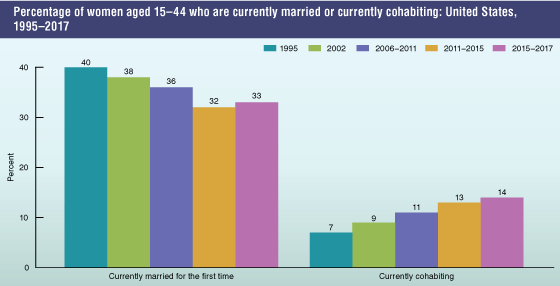National Survey of Family Growth
NCHS Fact Sheet, March 2019
PDF Version pdf icon(332 KB)
About NCHS
The National Center for Health Statistics (NCHS) is the nation’s principal health statistics agency, providing data to identify and address health issues. NCHS compiles statistical information to help guide public health and health policy decisions.
Collaborating with other public and private health partners, NCHS uses a variety of data collection mechanisms to obtain accurate information from multiple sources. This process provides a broad perspective on the population’s health, influences on health, and health outcomes.
National Survey of Family Growth
The National Survey of Family Growth (NSFG) collects information on families, fertility, and health from a national sample of males and females aged 15−49 in the household population of the United States.
NSFG was conducted five times periodically between 1973 and 1995 with a national sample of females aged 15−44. A sixth periodic survey, conducted in 2002, included both males and females aged 15−44. In 2006, NSFG shifted to a continuous ongoing survey design, interviewing males and females. In September 2015, the age range was expanded to males and females aged 15−49.
Topics addresses include:
- Marriage, divorce, cohabitation
- Women’s pregnancy and birth history, and men’s fathering of biological children
- Breastfeeding
- Adoption and nonbiological parenting
- Contraceptive use
- Intendedness of pregnancies
- Sexual intercourse and number of sexual partners
- Family planning and related medical services
- Infertility and use of infertility services
- Attitudes on sex, parenthood, marriage, and cohabitation
- Men’s involvement as fathers with children they do and do not live with
- Other sexual behaviors (besides vaginal intercourse) that may carry risk of HIV or sexually transmitted infections, including same-sex behavior
- Sexual orientation and attraction
Current contraceptive status
During 2015–2017, the most common methods of contraception currently used among females aged 15−49 in the United States were:
- Female sterilization (18.6%)
- The pill (12.6%)
- Long-acting reversible contraception (e.g., intrauterine devices and implants) (10.3%)
- Male condom (8.7%)
 image icon
image icon
1Significant linear trend.
2Significantly different from non-Hispanic black women.
NOTES: Total includes women of other and multiple race and origin groups, not shown separately. Analyses of education are limited to women aged 22–44 at the time of interview.
SOURCE: NCHS, National Survey of Family Growth, 2015–2017.
 image icon
image icon
SOURCE: NCHS, National Survey of Family Growth, 1995, 2002, 2006–2010, 2011–2015, and 2015–2017.
The percentages of women currently using any contraceptive method during 2015–2017 show:
- About 65% of women aged 15–49 (64.9%) were currently using a method of contraception.
- Current contraceptive use increased with age, from 37.2% among women aged 15–19 to 73.7% among women aged 40–49.
- The percentage of non-Hispanic white women currently using contraception (67.0%) was higher compared with non-Hispanic black women (59.9%), but not different from the percentage for Hispanic women (64.0%).
- Current contraceptive use did not differ significantly by education (68%–76%).
Marriage and cohabitation, 1995–2017
During 2015–2017, 54.0% of women and 47.5% of men aged 15–49 reported that they had ever been married. More than one-half of men (52%) and women (57%) aged 15–49 during 2015–2017 have cohabited at some time.
- The percentage of women aged 15–44 who were currently in their first marriage has gone down over the past several decades, from 40% in 1995 to 33% during 2015–2017.
- The percentage of women aged 15–44 who were cohabitating increased from 7% in 1995 to 14% during 2015–2017.
Additional findings from the 2015-2017 NSFG
- About 23% of men aged 45−49 had not fathered any children, 16% had fathered one child, 33% had fathered two, and 28% had fathered three or more children.
- About 15% of women aged 45−49 had not had any children, 18% had one child, 34% had two, and 33% had three or more children.
- About 25% of women aged 15–44 (24.9%) and 16.2% of men aged 15–44 had been tested for HIV in the past year.
- Approximately 57% of women aged 15–49 (56.4%) received a Pap test in the past 12 months.
- The average number of children expected by women in their lifetime was 2.2.
- Among men and women aged 15–49, 2.2% of men and 1.5% of women had five or more opposite-sex sexual partners in the past year.
Challenges and future opportunities
Future plans for NSFG include releasing the 2017–2019 data in 2020, planning the next NSFG survey contract with a focus on continuity of measures in core areas, and adapting as needed to respond to changes in data needs in reproductive health, family planning, and family formation. The survey will also continue to implement strategies to make continuous interviewing as efficient as possible in light of declining response rates and other challenges.
For more information about NCHS, visit https://www.cdc.gov/nchs.
For more information about NSFG, visit https://www.cdc.gov/nchs/nsfg.htm.